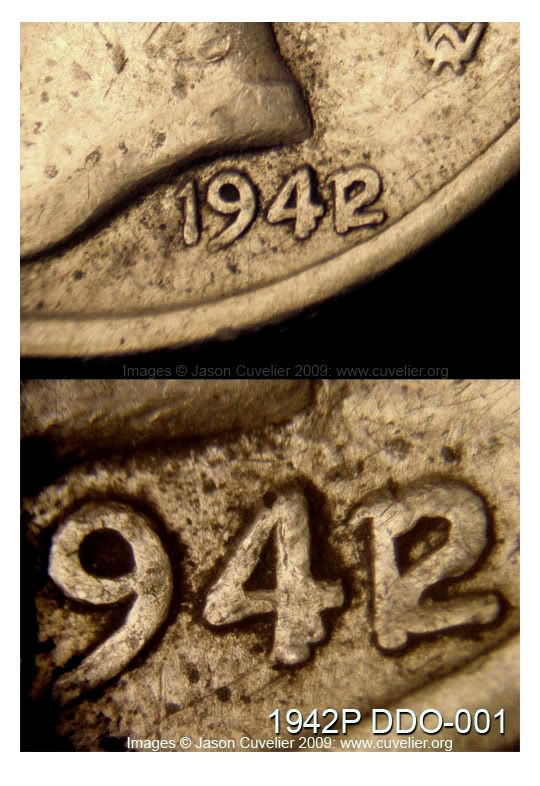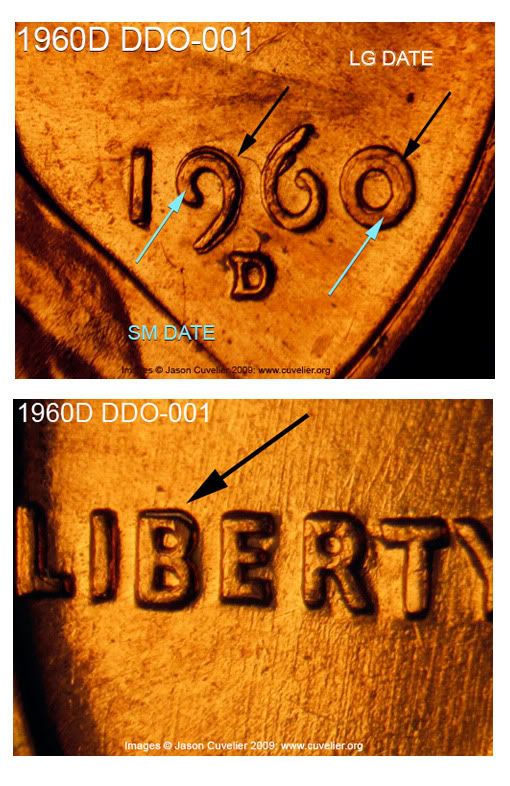Doubled Dies: Class III (Design hub Doubling) (LINK):
Likely the easiest Doubled Die to explain yet the least common to have occurred. Class III Doubled Dies occur when after the first hubbing with one design another hubbing follows of a different design or a slightly altered design.
Below is an overlay diagram of a fictitious Class III Doubled Die that is similar to several Doubled Dies that occurred during 1960 when the Mint used two different Master Dies, the first bearing a small date, then another made later that year bearing a larger date. You can see clear doubling in the date and then slight doubling in LIBERTY.
Doubling is sometimes the least dramatic characteristic observed as in some cases, with other denominations, such as on a Mercury Dime with a 1942 over a 1941 designated as 1942P DDO-001 (FS-10.7 [101] when, for whatever reason, a die after having been hubbed with a 1941 hub was hubbed a second time with a hub having a 1942. There is some doubling in IGWT, but there is a very dramatic, naked eye obvious overdate. It is important to note that all overdates after 1907 are Doubled Dies whereas previous overdates had dates punched into the die one on top of the other.
Collectors of Lincoln cents should have an easy time understanding what would happen if a 1960 small date hub and a 1960 large date hub were both used to create a die. There are four cases of this happening, three on proofs and one business strike from Denver (which also has a nice RPM). Below is an approximation overlay of a small date over a large date with an example designated as 1960P DDO-002 (FS-102). The doubling is very obvious in the date, LIBERTY and parts of IGWT. At the bottom the small date is lavender while the large is green; the first shows a small over a large and the second shows a large over a small. They almost line up perfectly with DDO-002.
The Denver version is just as dramatic in the date but less so in LIBERTY. The small date almost looks as if it were placed on top of the large date; it is listed as 1960D DDO-001 RPM-100 and is illustrated below. John Wexler states (The Cherrypicker’s Guide to Rare Die Varieties, 4th edition, volume one, 2001) that in the “early days” any Doubled Die that “…did not fit the parameters of any of the other classes of doubling” were often erroneously designated as a Class III Doubled Die. Wexler also says that “[he] will not assign a Class III designation to a variety unless [he] has documented evidence that different designs were in use [that] year….”
Another curious set of examples comes from 1949 when, for reasons unknown, three dies were hubbed with a pointed topped 4 hub and then hubbed again with a blunt topped 4. They are listed as 1949S DDO-001, 002 & 003. It has been theorized that the pointed hub is that from a 1948 that was absent an 8 digit or had 8 removed. Below is DDO-002 and then an approximation overlay showing a pointed 4 (red) from 1948 under a blunt 4 (green) from a 1949. They match up convincingly and suggest the likeliest, but not necessarily the only possible explanation. As a suggested reason for this (BJ Neff) suggested the possibility that the Mint was short on hubs and quickly altered an extra 1948. What isn’t answerable is why there are just thee examples that were only hubbed once using this particular hub. Could there be a non DDO pointed 4 1949S lurking out there yet to be found...
Finally a more complete picture of the dramatic doubling found on 1960P DDO-002:

Welcome guest, is this your first visit? Click the "Create Account" button now to join.
Results 1 to 9 of 9
Thread: Class III (Design Hub Doubling)
Threaded View
-
01-05-2010 #1
Class III (Design Hub Doubling)
Jason Cuvelier
MadDieClashes.com - ErrorVariety.com
TrailDies.com - Error-ref.com - Port.Cuvelier.org
CONECA
(images © Jason Cuvelier 2008-18)___________________
-
Post Thanks / Like - 1 Thanks, 1 Likes













 Reply With Quote
Reply With Quote

Bookmarks